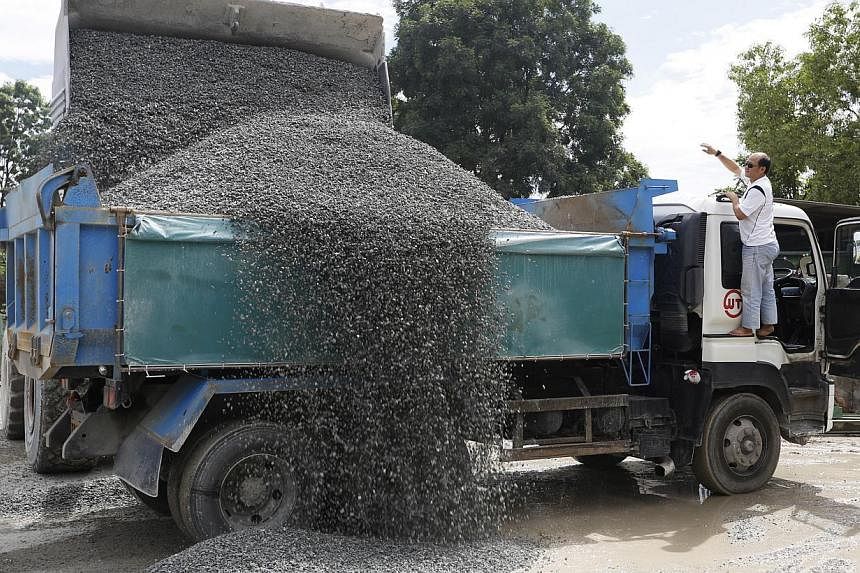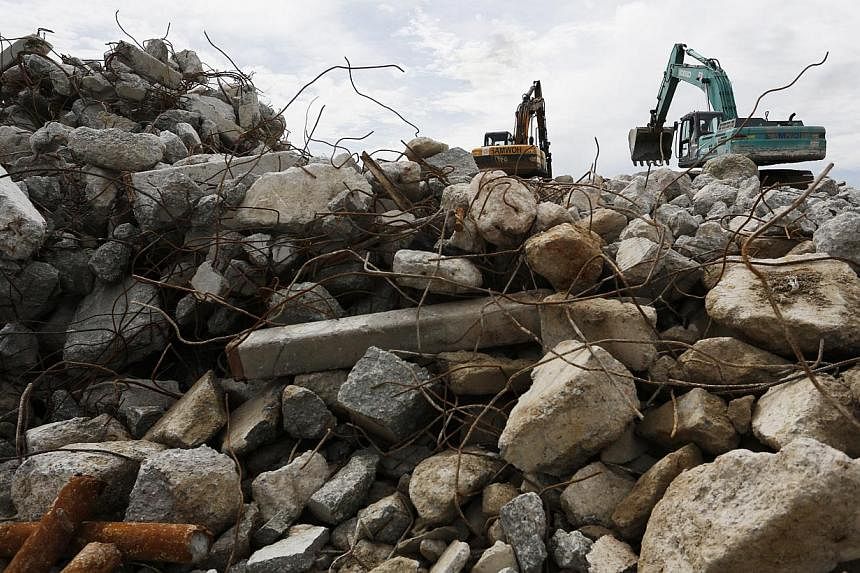THE first thing you notice about Sarimbun Recycling Park is the dust.
Wood dust, charcoal dust and recycled-concrete grit, kicked up by trucks and blown aloft by wind, coat every surface.
A battered truck that looks like it should be destined for scrap trundles along the potholed road and up a steep slope, while another carrying a load of tree branches and leaves resembles a rolling hedge.
There is more to the 30ha facility near the end of Lim Chu Kang Road than just dust, however. Tucked away in a north-western corner of Singapore, the industrial park's 13 plants handle a full one-quarter of Singapore's recycling.
In other words, they re-used nearly 1.2 million tonnes of the 4.8 million recycled in total. The rest is handled mainly at plants in Tuas, Jurong and Sungei Kadut.
They turn construction waste into recycled material for roads and buildings, scrap tyres into flooring, horticultural waste into compost and charcoal, and manufacturers' plastic scrap into neat sacks of plastic pellets. Thousands of tonnes of material are piled onto a hilly moonscape in each compound.

Earlier this month, the National Environment Agency (NEA) said it was looking into the feasibility of a multi-storey, consolidated recycling plant at Sarimbun Recycling Park, or elsewhere in Lim Chu Kang, and would work with the Urban Redevelopment Authority and JTC Corporation on the project.
The facility is not meant to consolidate all recycling companies into a single location, an NEA spokesman said. Rather, the study aims to find out if different recycling activities can be stacked to intensify land use.
In 2030, Singapore is expected to produce 12.3 million tonnes of rubbish based on population and economic growth estimates, up from 7.9 million tonnes last year.
By then, it aims to be recycling 70 per cent of all waste produced here, up from the current 61 per cent.
While that is a good idea, said Sarimbun's current tenants, they were nervous about their own fate.
Sarimbun Recycling Park opened in 1995 at the edge of the old Lim Chu Kang dumping ground, which closed in 1992.
The landfill itself, opened in 1976, was adjacent to the Sarimbun Scout Camp. Before it was a landfill, it was a mangrove swamp abutting the Strait of Johor, said those familiar with the area.
"We used to catch frogs, tadpoles and even grass snakes there," said Dr Effendy Rajab, 59, executive director of the Singapore Scout Association.
"I was quite upset when they filled the land, because it covered up all the natural beauty of the land. There were also a lot of flies that swarmed the campsite and the landfill stopped up the flow of water to the sea," he added.
"I used to take my scouts there to camp in the 1980s and it didn't smell nice."
Today, there are no flies, and the only smell is a smoky-sweet one from compost. There is a constant buzz but it is from waste being shredded, crushed, ground, loaded and unloaded.
Most plants run from 7am to 7pm. Getting there on the lone public bus service 975 from Bukit Panjang can take more than an hour.
In fact, companies there find it next to impossible to hire Singaporean or Malaysian workers.
"When they hear it's Lim Chu Kang and waste, they don't want to work here," said Mr Nehemiah Teo, 50, operations director of horticultural waste recycler GreenBack.
Workers are mainly from India and China, and most live in the Sungei Kadut dormitories a 15-minute drive away.
Even motorists run into trouble.
"The first time I came here I got a flat tyre," said Dr Low Boon Hwee, 49, executive director of infrastructure firm Ley Choon Group Holdings, which runs a construction-waste recycling plant there. There are bits of metal, nails and other sharp objects on the road in the park, he cautioned.
At lunchtime, a supervisor may go out to buy food from a Sungei Kadut or Jurong coffee shop. Other times, workers cook.
At Samwoh's construction-waste recycling plant, worker Jagsir Singh, 37, from India, was stirring curry at a shelter made from a shipping container.
Even with the wall and a barrier of cement blocks, he said, "it's very noisy and dusty all the time".
Tenants also wondered if the former landfill was stable enough to build a multi-storey plant on.
"How high can you build? Would it sink?" wondered Mr Dave Wong, 52, business development manager of plastic recycling firm Eveready Manufacturing.
The idea of consolidating facilities, electricity and water supply is a good one, he said. The area is not connected to the national grid and recycling plants there still have to generate their own electricity from diesel.
Just one, Ley Choon's construction-waste plant, secured permission to be wired up to the national grid and installed its own substation. It did so for a stable power supply, said Dr Low.
And GreenBack, which makes compost and charcoal, heats its charcoal reactor to 1,000 deg C with wood gas from the charcoal-making process.
Rent ranges from $1 to $4 per sq m per month depending on the types of recycling activity, and leases are nine years long.
"We're starting to get worried now about what will happen when our lease runs out four years from now," said Dr Low.
If there is no room to recycle Ley Choon's concrete and asphalt waste from its other activities, the waste must be sold or disposed of.
And while the NEA wants its consolidated facility to recycle at least 12 tonnes of waste per sq m each year or meet other targets, there is a limit to how much firms can intensify land use, they said. For instance, composting needs to be done in the open and the compost heaps turned and aerated, said Mr Teo.
Mr Wong said: "Recycling companies don't need a nice factory. We just need more space."




